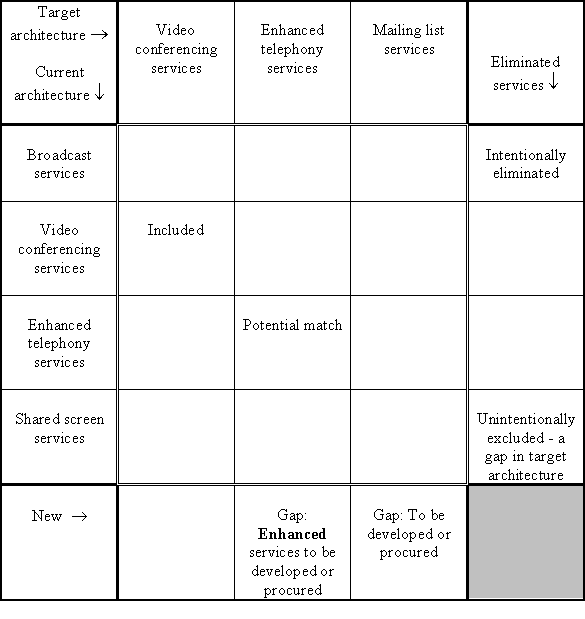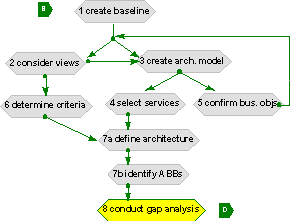8. Conduct a gap analysis
Objective Approach
Inputs Activities
Outputs
The objective of this step is to identify areas of the current and target system for
which provision has not been made in the Technology Architecture. This is required in
order to identify projects to be undertaken as part of the implementation of the target
system.
A key step in validating an architecture is to consider what may have been forgotten.
The architecture must support all of the essential information processing needs of the
organization, as driven by the required applications. The most critical
source of gaps that should be considered is stakeholder concerns that have not been
addressed in subsequent architectural work.
Gap analysis highlights services and/or functions that have been accidentally left out,
deliberately eliminated, or are yet to be developed or procured:
- Draw up a matrix with all the business functions of the current architecture on the
vertical axis, and all the business functions of the target Technology architecture on the
horizontal axis. In creating the matrix it is imperative to use terminology that is
accurate and consistent.
- Add to the Current Architecture axis a final row labeled 'New Services', and to the
Target Architecture axis a final column labeled 'Eliminated Services'.
- Where a function is available in both the current and target architectures, record this
with 'Included' at the intersecting cell.
- Where a function from the current architecture is missing in the target architecture (in
the example, "broadcast services" and "shared screen services"), each
must be reviewed. If it was correctly eliminated, mark it as such in the appropriate
'Eliminated Services' cell. If it was not, you have uncovered an accidental omission in
your new architecture that must be addressed by reinstating the function in the next
iteration of the design - mark it as such in the appropriate 'Eliminated Services' cell.
- Where a function from the target architecture cannot be found in the current
architecture (in the example, "mailing list services"), mark it at the
intersection with the 'New' row, as a gap that needs to filled, either by developing or
procuring the function.
When the exercise is complete, anything under 'Eliminated Services' or 'New Services'
is a gap, which should either be explained as correctly eliminated, or marked as to be
addressed by reinstating or developing/procuring the function.
Table 1 shows an example from the Network Services category when functions from the
current architecture are missing from the target architecture:

Table 1: A Gap Analysis Matrix
The inputs to this step are:
Key activities in this step include:
- Create gap matrix as described under Approach, above.
- Identify building blocks to be carried over, classifying as either changed or unchanged.
- Identify eliminated building blocks.
- Identify new building blocks.
- Identify gaps and classify as those that should be developed, those that should be
procured, and those inherited.
The output of this step is:
Postscript
Copyright © The Open Group, 1998, 1999, 2002
 Objective
Objective Objective
Objective